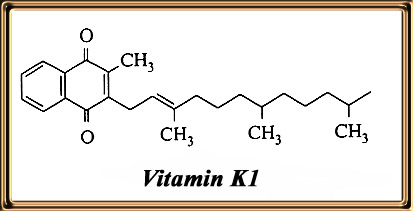Vitamin K1 was named phylloquinone since it is an indirect product of photosynthesis in plant leaves where it occurs in chloroplasts and participates in the overall photosynthetic process. The methyl naphthoquinone ring has a phytyl side chain (partially saturated polyisoprenoid alcohol). Anticoagulant rodenticides interfere with the vitamin K-dependent carboxylation of factors II, VII, IX and X by inhibiting the epoxide-reductase enzyme necessary for the recycling of vitamin K, thus depleting body stores of vitamin K. As a result, only nonfunctional precursors of the vitamin K-dependent factors are synthesized. Coumarin compounds including warfarin, coumafuryl, brodifacoum, and bromadiolone have a half-life of up to 55 hours. In contrast, indanedione compounds (pindone, valone, diphacinone and chlorophacinone) have a half-life as long as 4 to 5 days and can affect hemostasis for as long as 30 days. In addition, the indanedione compounds may interfere with exocrine pancreatic function resulting in reduced intestinal absorption of vitamin K. It is insoluble in water, soluble in chloroform and slightly soluble in ethanol. It has a molecular weight of 450.70.Chemical Name: 2-methyl-3-phytyl-1, 4-naphthoquinone.
Chemical Formula: C31H46O2
Chemical Structure:
Phylloquinone is abundant in green vegetables (0.4, 1, 1.8, 4 and 8µg/g in peas, lettuce, Brussel sprout, spinach and kale, respectively) but poorly represented in fruits (1 to 30 ng/g) except avocado (400 ng/g) and kiwi (250 ng/g). Grain products have also very low levels of vitamin K1 (1 to 70 ng/g) . Animal products including eggs do not appear to contain appreciable amounts of vitamin K1 (less than 50 ng/g) and less than 10 ng/g are found in fish and shellfish. High amounts are found in butter (up to 1 µg/g) but lower amounts in cheese (20-100 ng/g). In contrast, a high diversity of menaquinones are present in dairy products.
Because of the marked difference in the duration of action of coumarin versus indanedione compounds, identification of the specific compound ingested by the person or animal is important in planning treatment. It must be realized that it takes several hours for vitamin K to work, when administered by any route. Therefore, in life-threatening situations (intracavity or CNS hemorrhage), a source of active coagulation factors must be given and vitamin K should not be relied upon to provide immediate hemostasis.
